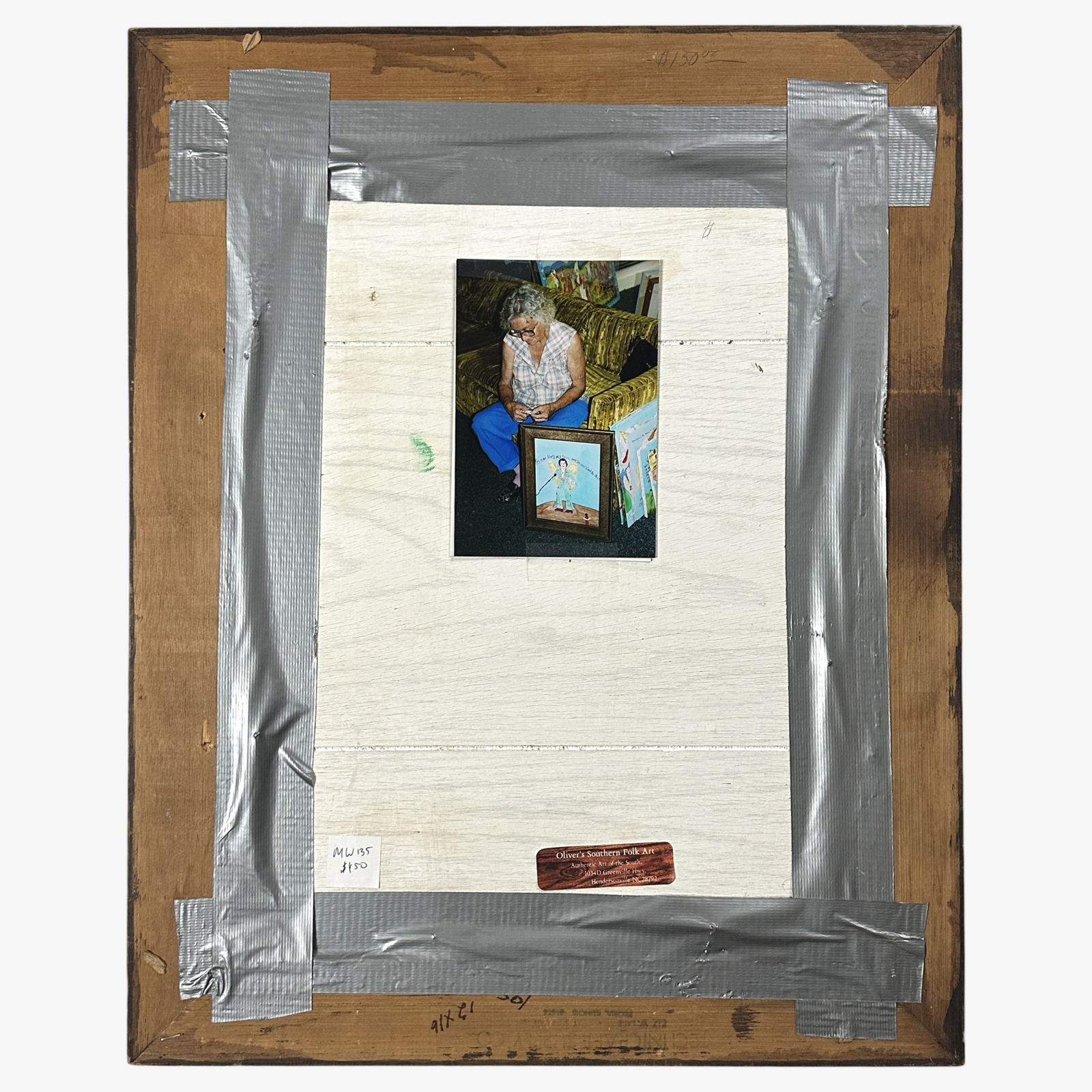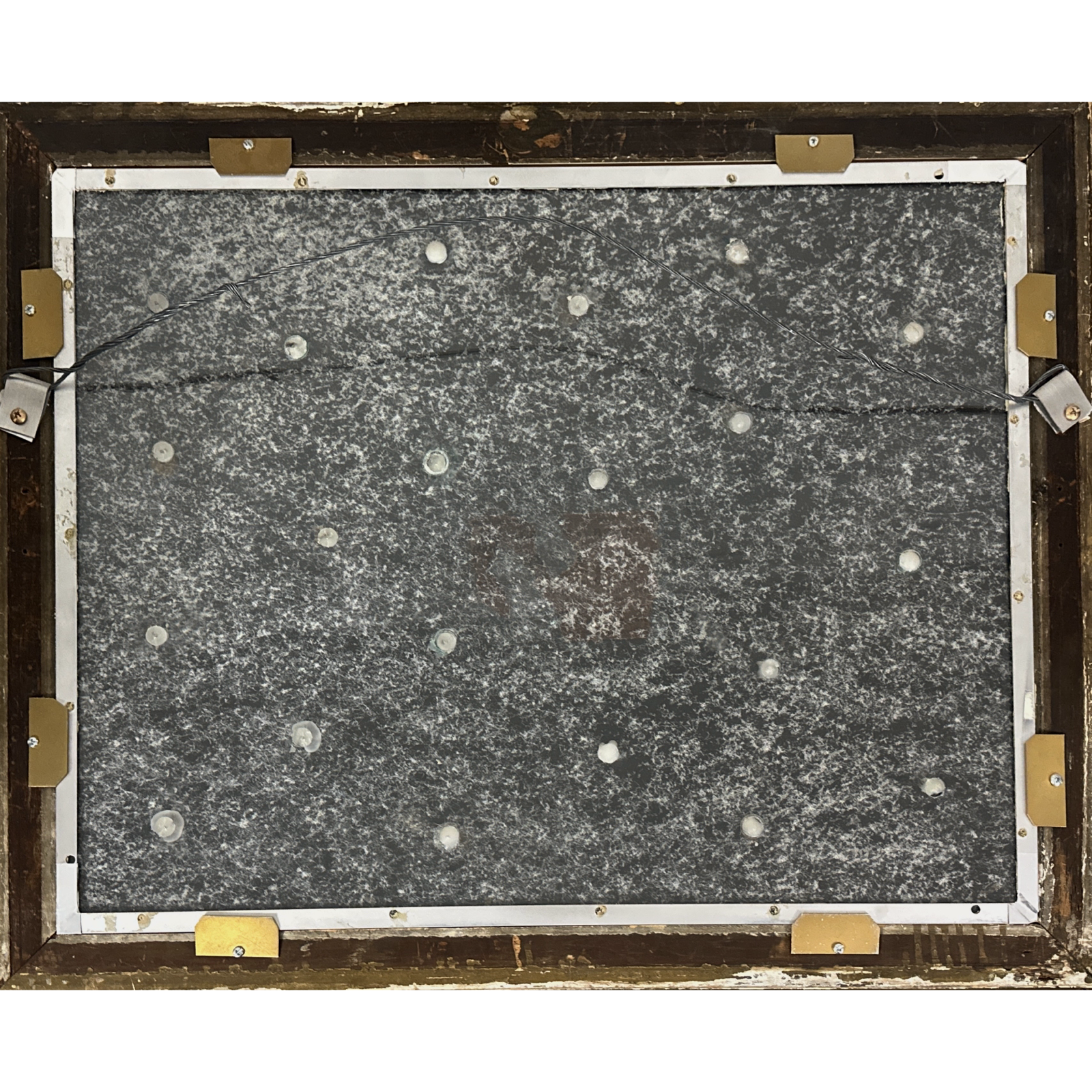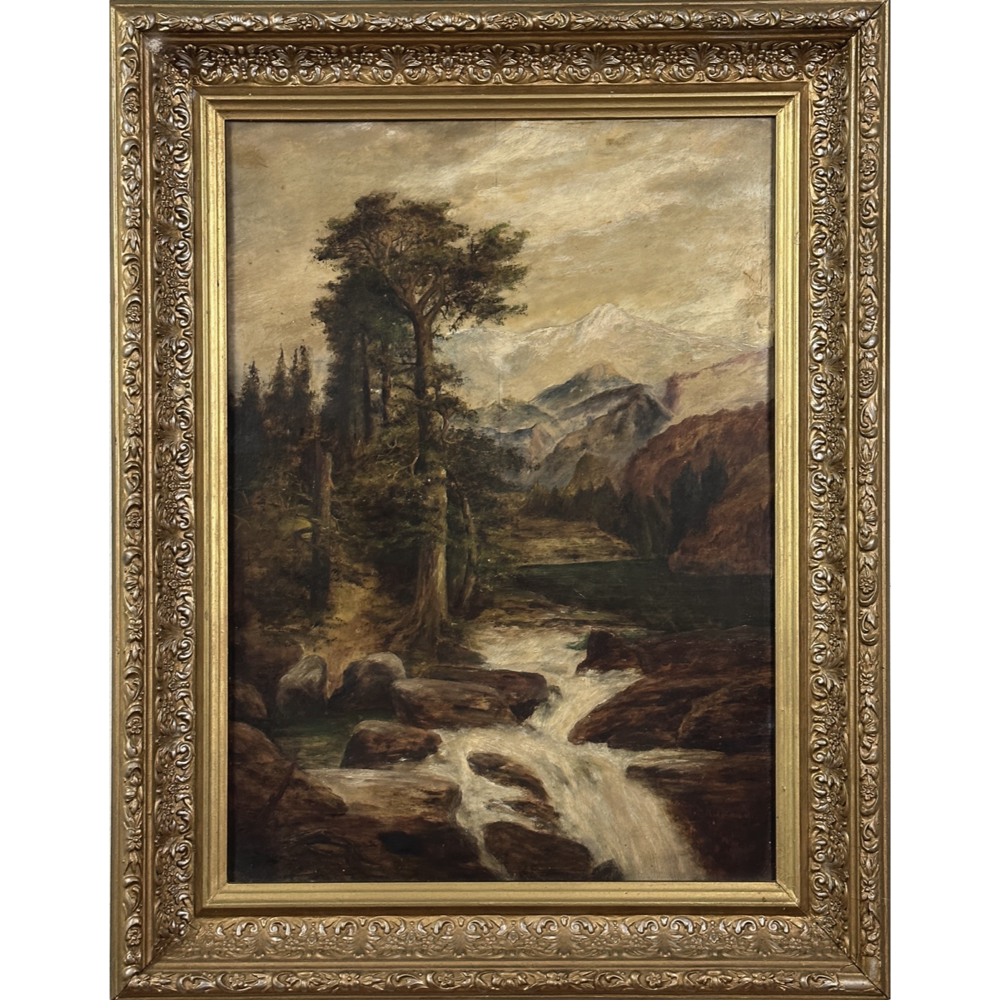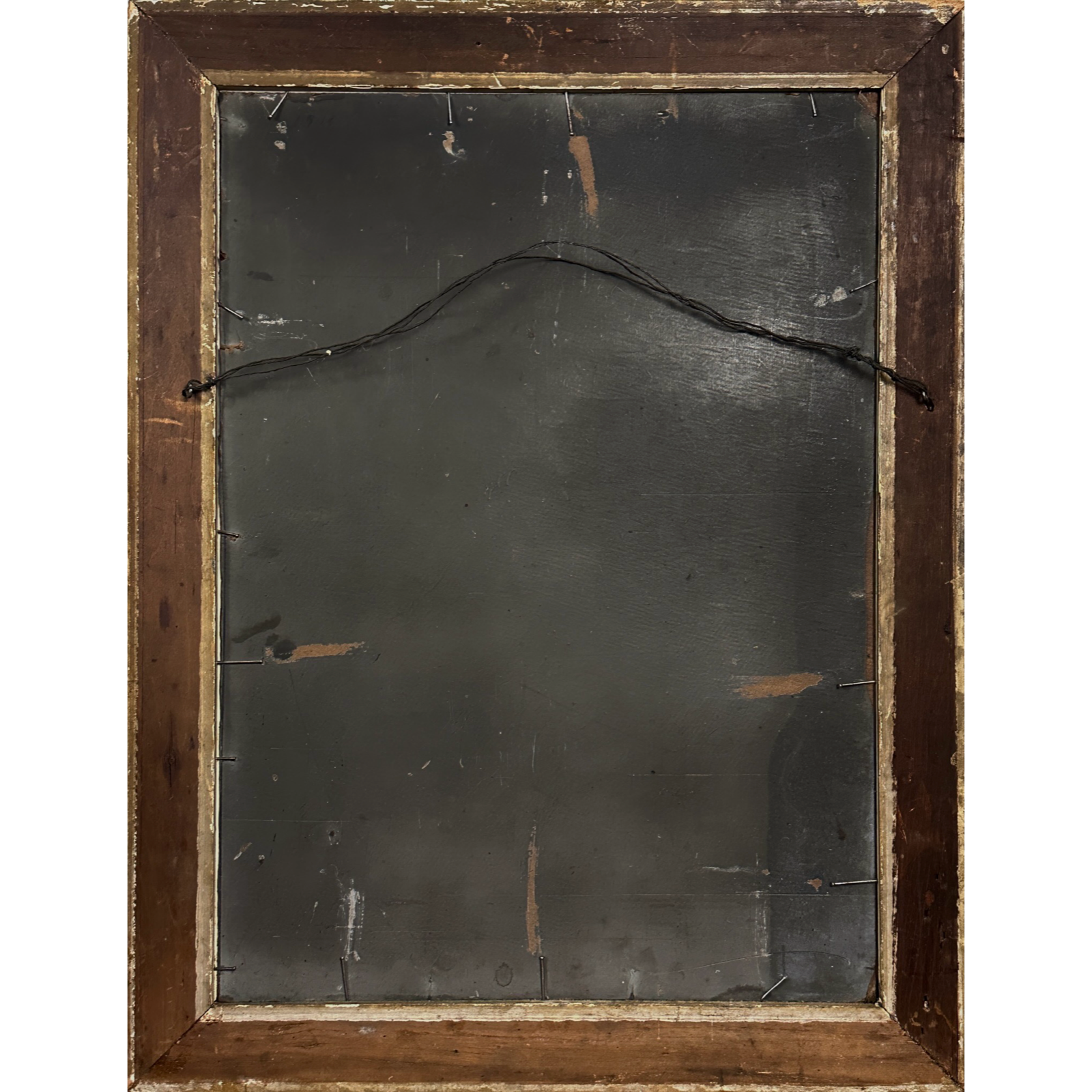 Image 1 of 7
Image 1 of 7

 Image 2 of 7
Image 2 of 7

 Image 3 of 7
Image 3 of 7

 Image 4 of 7
Image 4 of 7

 Image 5 of 7
Image 5 of 7

 Image 6 of 7
Image 6 of 7

 Image 7 of 7
Image 7 of 7








Myrtice West (1923-2010) - Outsider Singing Angel Elvis Painting, Signed (Oil on Board)
Myrtice West (1923-2010) - Outsider Singing Angel Elvis Painting, Signed (Oil on Board). Portrait of Elvis as an Angel singing with the text: “Them Sing My Soul My Savor God to Thee”. Glitter attached to the wings and the pants. Signed in the lower right corner. Housed in the original frame. Original photo en verso with the painting by her side acts as provenance. Original tag of Oliver’s Southern Folk Art Gallery en verso. In good condition with wear consistent with age.
Size: 16.25 x 20.25 in
Described as part Grandma Moses, part Hieronymus Bosch, Alabama-born Myrtice West belongs to the special category of “visionary” artists. Her biblical paintings have a feeling of prophetic urgency about them, as if the self-taught painter had a message to communicate, which she needed to get down quickly, applying oil and acrylic paint in thin coats and washes to whatever surface materials she had at hand. West is best known for a cycle paintings, illustrating the last book of the Bible, Revelation. These highly detailed pieces filled with angels, demons, and multi-headed monsters give figurative expression to the symbolic language of St. John’s apocalyptic vision and are steeped in conservative Protestant teachings about the End of Time.
West believed she was inspired by God to create The Revelations Series in the early hours of the morning in 1978, as she sat in her kitchen, reading her Bible, praying, and agonizing over her only child, Martha Jane, who was trapped in an abusive marriage. In a self-published booklet in 1983, the artist described how she felt "as if someone else held the brush,” when she created the cycle of paintings. Said West: “Unless Christ comes in, I can’t explain how I did these pictures or why.’
Religious faith always provided a firm foundation for this “outsider” artist, who grew up on a cotton farm in Northern Alabama and lived most of her life just a few miles from where she was born. The family was denominationally-divided between Methodists and Baptists, so, West attended both churches when she was a young girl. She was drawn to the Fundamentalist Baptist tradition with its belief in the literal interpretation of the Bible and in dispensationalist theology about the Second Coming of Christ, the inspiration for some of her finest works.
West dabbled with drawing as a child, but she never had formal art training and left school in the eighth grade. She learned to tint photographs to supplement the family income after she married in her teens, but her first real time of “inspired” art-making followed two miscarriages and surgery for a cancerous stomach tumor. As West recalled: “I lay around and drew pictures of Jesus and the depression passed.” She was finally able to conceive a child and considered Martha Jane to be a special blessing from God.
For seven long years, West channeled her fears and anxieties about her daughter's troubled marriage into the bold imagery of The Revelations Series. Martha Jane finally got a divorce in 1985, and in the same year the artist finished the last of the 13 paintings. Then, in 1986, West's worst forebodings were realized. Martha Jane was murdered by her ex-husband. West turned to art once more for consolation, as she tried to make a new life for her two grandchildren and cared for an aging mother and husband, suffering from cancer. She was in her late 60s, when she first came to the notice of the art world, thanks to her grandson, Bram, who nominated her for the Alabama Governor’s Art Award in 1990.
West did two more series of paintings on prophetic books of the Bible, Ezekiel and Daniel, and was working on a cycle on Zechariah, when a fire destroyed her home in 2000. The Sacred Art Pilgrim Collection has acquired, Zechariah, Chapter Two, which is almost certainly one of three original canvases from the cycle, which survived the disaster. Combining images with biblical texts from the King James Version, West begins her complex visual narrative in the lower right corner, showing "the man with the measuring line in his hand," mentioned in Zechariah 2:1 with the verse written out underneath. The story of God's protective love for Jerusalem, then, develops, sequentially, in visual vignettes and verses in a counter clockwise oval, ending in the upper right corner with an image of the Lord (represented, throughout, by Christ), who appears to "all flesh" beside the text of Zechariah 2:13.
West considered her art pieces to be visual sermons. A fine example in the collection is Living Water II, one of West's many "second generation" copies of earlier works, which lack the painterly finish of the originals. Christ's discourse about "living water" with the Samaritan Woman at the well (John 4: 5-28) at the bottom finds resonance in images of the Children of Israel Crossing the Red Sea (Exodus 14:15-30); Noah in the Ark (Genesis 6-8); and the Baptism of Christ (Matthew 3:13-17), seen in the river at the center of the picture. The Ten Commandments, representing Divine Law, are placed just to the left of the Virgin Mary, the baby Jesus, and the adult Christ, who symbolize the Grace of God. The Redemption theme is echoed on the pages of the Bible, below, where the Temptation of Adam and Eve contrasts with a scene of Jesus explaining God's plan of salvation to Nicodemus (John 3:16).
Like the artist's near contemporary, Fellow Southerner Howard Finster, West made text an integral part of her art in works like Zechariah, Chapter Two. Other text art pieces in the collection include Jesus in the Garden with West's handwritten commentary of what happened in Gethsemane the night Christ was betrayed and Good Friday, which includes quotes from the New Testament Passion narratives. Since the restoration of the Jewish state plays an important role in Fundamentalist views of the End of Time, West turns The Good Samaritan into an object lesson about American support for Israel. This is also the theme of a larger canvas, where Christ stands before an American flag and a group of buildings, which appears to include the U.S. Capitol and sacred sites in the Holy Land. The title, Pray for the Peace of Israel, is taken from Psalm 122.6.
As you would expect in the works of a visionary artist, angels figure prominently in West's iconography. They can be seen struggling with Jacob in Jacob Wrestles the Angel, hovering above the River Jordan in The Baptism of Jesus, floating in the air in Christ on the Cross, and sounding trumpets in The Second Coming. West decorated the veranda of her home in Centre, Alabama, with hanging wooden cut-outs of angels and even placed a little red angelic "on-looker" just to the left of the signature in her paintings.
Biographical material from Wonders to Behold: The Visionary Art of Myrtice West, edited by Carol Crown (Mustang Publishing, Memphis: 1999.)
Myrtice West (1923-2010) - Outsider Singing Angel Elvis Painting, Signed (Oil on Board). Portrait of Elvis as an Angel singing with the text: “Them Sing My Soul My Savor God to Thee”. Glitter attached to the wings and the pants. Signed in the lower right corner. Housed in the original frame. Original photo en verso with the painting by her side acts as provenance. Original tag of Oliver’s Southern Folk Art Gallery en verso. In good condition with wear consistent with age.
Size: 16.25 x 20.25 in
Described as part Grandma Moses, part Hieronymus Bosch, Alabama-born Myrtice West belongs to the special category of “visionary” artists. Her biblical paintings have a feeling of prophetic urgency about them, as if the self-taught painter had a message to communicate, which she needed to get down quickly, applying oil and acrylic paint in thin coats and washes to whatever surface materials she had at hand. West is best known for a cycle paintings, illustrating the last book of the Bible, Revelation. These highly detailed pieces filled with angels, demons, and multi-headed monsters give figurative expression to the symbolic language of St. John’s apocalyptic vision and are steeped in conservative Protestant teachings about the End of Time.
West believed she was inspired by God to create The Revelations Series in the early hours of the morning in 1978, as she sat in her kitchen, reading her Bible, praying, and agonizing over her only child, Martha Jane, who was trapped in an abusive marriage. In a self-published booklet in 1983, the artist described how she felt "as if someone else held the brush,” when she created the cycle of paintings. Said West: “Unless Christ comes in, I can’t explain how I did these pictures or why.’
Religious faith always provided a firm foundation for this “outsider” artist, who grew up on a cotton farm in Northern Alabama and lived most of her life just a few miles from where she was born. The family was denominationally-divided between Methodists and Baptists, so, West attended both churches when she was a young girl. She was drawn to the Fundamentalist Baptist tradition with its belief in the literal interpretation of the Bible and in dispensationalist theology about the Second Coming of Christ, the inspiration for some of her finest works.
West dabbled with drawing as a child, but she never had formal art training and left school in the eighth grade. She learned to tint photographs to supplement the family income after she married in her teens, but her first real time of “inspired” art-making followed two miscarriages and surgery for a cancerous stomach tumor. As West recalled: “I lay around and drew pictures of Jesus and the depression passed.” She was finally able to conceive a child and considered Martha Jane to be a special blessing from God.
For seven long years, West channeled her fears and anxieties about her daughter's troubled marriage into the bold imagery of The Revelations Series. Martha Jane finally got a divorce in 1985, and in the same year the artist finished the last of the 13 paintings. Then, in 1986, West's worst forebodings were realized. Martha Jane was murdered by her ex-husband. West turned to art once more for consolation, as she tried to make a new life for her two grandchildren and cared for an aging mother and husband, suffering from cancer. She was in her late 60s, when she first came to the notice of the art world, thanks to her grandson, Bram, who nominated her for the Alabama Governor’s Art Award in 1990.
West did two more series of paintings on prophetic books of the Bible, Ezekiel and Daniel, and was working on a cycle on Zechariah, when a fire destroyed her home in 2000. The Sacred Art Pilgrim Collection has acquired, Zechariah, Chapter Two, which is almost certainly one of three original canvases from the cycle, which survived the disaster. Combining images with biblical texts from the King James Version, West begins her complex visual narrative in the lower right corner, showing "the man with the measuring line in his hand," mentioned in Zechariah 2:1 with the verse written out underneath. The story of God's protective love for Jerusalem, then, develops, sequentially, in visual vignettes and verses in a counter clockwise oval, ending in the upper right corner with an image of the Lord (represented, throughout, by Christ), who appears to "all flesh" beside the text of Zechariah 2:13.
West considered her art pieces to be visual sermons. A fine example in the collection is Living Water II, one of West's many "second generation" copies of earlier works, which lack the painterly finish of the originals. Christ's discourse about "living water" with the Samaritan Woman at the well (John 4: 5-28) at the bottom finds resonance in images of the Children of Israel Crossing the Red Sea (Exodus 14:15-30); Noah in the Ark (Genesis 6-8); and the Baptism of Christ (Matthew 3:13-17), seen in the river at the center of the picture. The Ten Commandments, representing Divine Law, are placed just to the left of the Virgin Mary, the baby Jesus, and the adult Christ, who symbolize the Grace of God. The Redemption theme is echoed on the pages of the Bible, below, where the Temptation of Adam and Eve contrasts with a scene of Jesus explaining God's plan of salvation to Nicodemus (John 3:16).
Like the artist's near contemporary, Fellow Southerner Howard Finster, West made text an integral part of her art in works like Zechariah, Chapter Two. Other text art pieces in the collection include Jesus in the Garden with West's handwritten commentary of what happened in Gethsemane the night Christ was betrayed and Good Friday, which includes quotes from the New Testament Passion narratives. Since the restoration of the Jewish state plays an important role in Fundamentalist views of the End of Time, West turns The Good Samaritan into an object lesson about American support for Israel. This is also the theme of a larger canvas, where Christ stands before an American flag and a group of buildings, which appears to include the U.S. Capitol and sacred sites in the Holy Land. The title, Pray for the Peace of Israel, is taken from Psalm 122.6.
As you would expect in the works of a visionary artist, angels figure prominently in West's iconography. They can be seen struggling with Jacob in Jacob Wrestles the Angel, hovering above the River Jordan in The Baptism of Jesus, floating in the air in Christ on the Cross, and sounding trumpets in The Second Coming. West decorated the veranda of her home in Centre, Alabama, with hanging wooden cut-outs of angels and even placed a little red angelic "on-looker" just to the left of the signature in her paintings.
Biographical material from Wonders to Behold: The Visionary Art of Myrtice West, edited by Carol Crown (Mustang Publishing, Memphis: 1999.)
Myrtice West (1923-2010) - Outsider Singing Angel Elvis Painting, Signed (Oil on Board). Portrait of Elvis as an Angel singing with the text: “Them Sing My Soul My Savor God to Thee”. Glitter attached to the wings and the pants. Signed in the lower right corner. Housed in the original frame. Original photo en verso with the painting by her side acts as provenance. Original tag of Oliver’s Southern Folk Art Gallery en verso. In good condition with wear consistent with age.
Size: 16.25 x 20.25 in
Described as part Grandma Moses, part Hieronymus Bosch, Alabama-born Myrtice West belongs to the special category of “visionary” artists. Her biblical paintings have a feeling of prophetic urgency about them, as if the self-taught painter had a message to communicate, which she needed to get down quickly, applying oil and acrylic paint in thin coats and washes to whatever surface materials she had at hand. West is best known for a cycle paintings, illustrating the last book of the Bible, Revelation. These highly detailed pieces filled with angels, demons, and multi-headed monsters give figurative expression to the symbolic language of St. John’s apocalyptic vision and are steeped in conservative Protestant teachings about the End of Time.
West believed she was inspired by God to create The Revelations Series in the early hours of the morning in 1978, as she sat in her kitchen, reading her Bible, praying, and agonizing over her only child, Martha Jane, who was trapped in an abusive marriage. In a self-published booklet in 1983, the artist described how she felt "as if someone else held the brush,” when she created the cycle of paintings. Said West: “Unless Christ comes in, I can’t explain how I did these pictures or why.’
Religious faith always provided a firm foundation for this “outsider” artist, who grew up on a cotton farm in Northern Alabama and lived most of her life just a few miles from where she was born. The family was denominationally-divided between Methodists and Baptists, so, West attended both churches when she was a young girl. She was drawn to the Fundamentalist Baptist tradition with its belief in the literal interpretation of the Bible and in dispensationalist theology about the Second Coming of Christ, the inspiration for some of her finest works.
West dabbled with drawing as a child, but she never had formal art training and left school in the eighth grade. She learned to tint photographs to supplement the family income after she married in her teens, but her first real time of “inspired” art-making followed two miscarriages and surgery for a cancerous stomach tumor. As West recalled: “I lay around and drew pictures of Jesus and the depression passed.” She was finally able to conceive a child and considered Martha Jane to be a special blessing from God.
For seven long years, West channeled her fears and anxieties about her daughter's troubled marriage into the bold imagery of The Revelations Series. Martha Jane finally got a divorce in 1985, and in the same year the artist finished the last of the 13 paintings. Then, in 1986, West's worst forebodings were realized. Martha Jane was murdered by her ex-husband. West turned to art once more for consolation, as she tried to make a new life for her two grandchildren and cared for an aging mother and husband, suffering from cancer. She was in her late 60s, when she first came to the notice of the art world, thanks to her grandson, Bram, who nominated her for the Alabama Governor’s Art Award in 1990.
West did two more series of paintings on prophetic books of the Bible, Ezekiel and Daniel, and was working on a cycle on Zechariah, when a fire destroyed her home in 2000. The Sacred Art Pilgrim Collection has acquired, Zechariah, Chapter Two, which is almost certainly one of three original canvases from the cycle, which survived the disaster. Combining images with biblical texts from the King James Version, West begins her complex visual narrative in the lower right corner, showing "the man with the measuring line in his hand," mentioned in Zechariah 2:1 with the verse written out underneath. The story of God's protective love for Jerusalem, then, develops, sequentially, in visual vignettes and verses in a counter clockwise oval, ending in the upper right corner with an image of the Lord (represented, throughout, by Christ), who appears to "all flesh" beside the text of Zechariah 2:13.
West considered her art pieces to be visual sermons. A fine example in the collection is Living Water II, one of West's many "second generation" copies of earlier works, which lack the painterly finish of the originals. Christ's discourse about "living water" with the Samaritan Woman at the well (John 4: 5-28) at the bottom finds resonance in images of the Children of Israel Crossing the Red Sea (Exodus 14:15-30); Noah in the Ark (Genesis 6-8); and the Baptism of Christ (Matthew 3:13-17), seen in the river at the center of the picture. The Ten Commandments, representing Divine Law, are placed just to the left of the Virgin Mary, the baby Jesus, and the adult Christ, who symbolize the Grace of God. The Redemption theme is echoed on the pages of the Bible, below, where the Temptation of Adam and Eve contrasts with a scene of Jesus explaining God's plan of salvation to Nicodemus (John 3:16).
Like the artist's near contemporary, Fellow Southerner Howard Finster, West made text an integral part of her art in works like Zechariah, Chapter Two. Other text art pieces in the collection include Jesus in the Garden with West's handwritten commentary of what happened in Gethsemane the night Christ was betrayed and Good Friday, which includes quotes from the New Testament Passion narratives. Since the restoration of the Jewish state plays an important role in Fundamentalist views of the End of Time, West turns The Good Samaritan into an object lesson about American support for Israel. This is also the theme of a larger canvas, where Christ stands before an American flag and a group of buildings, which appears to include the U.S. Capitol and sacred sites in the Holy Land. The title, Pray for the Peace of Israel, is taken from Psalm 122.6.
As you would expect in the works of a visionary artist, angels figure prominently in West's iconography. They can be seen struggling with Jacob in Jacob Wrestles the Angel, hovering above the River Jordan in The Baptism of Jesus, floating in the air in Christ on the Cross, and sounding trumpets in The Second Coming. West decorated the veranda of her home in Centre, Alabama, with hanging wooden cut-outs of angels and even placed a little red angelic "on-looker" just to the left of the signature in her paintings.
Biographical material from Wonders to Behold: The Visionary Art of Myrtice West, edited by Carol Crown (Mustang Publishing, Memphis: 1999.)





















